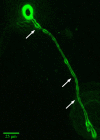Hydrogel systems and their role in neural tissue engineering
- PMID: 31910776
- PMCID: PMC7014813
- DOI: 10.1098/rsif.2019.0505
Hydrogel systems and their role in neural tissue engineering
Abstract
Neural tissue engineering (NTE) is a rapidly progressing field that promises to address several serious neurological conditions that are currently difficult to treat. Selecting the right scaffolding material to promote neural and non-neural cell differentiation as well as axonal growth is essential for the overall design strategy for NTE. Among the varieties of scaffolds, hydrogels have proved to be excellent candidates for culturing and differentiating cells of neural origin. Considering the intrinsic resistance of the nervous system against regeneration, hydrogels have been abundantly used in applications that involve the release of neurotrophic factors, antagonists of neural growth inhibitors and other neural growth-promoting agents. Recent developments in the field include the utilization of encapsulating hydrogels in neural cell therapy for providing localized trophic support and shielding neural cells from immune activity. In this review, we categorize and discuss the various hydrogel-based strategies that have been examined for neural-specific applications and also highlight their strengths and weaknesses. We also discuss future prospects and challenges ahead for the utilization of hydrogels in NTE.
Keywords: axonal growth; chemical cues; hydrogel; neural tissue engineering; physical guidance.
Conflict of interest statement
We declare we have no competing interests.
Figures



References
Publication types
MeSH terms
Substances
LinkOut - more resources
Full Text Sources
Research Materials

